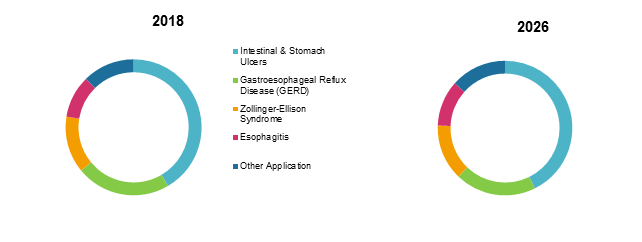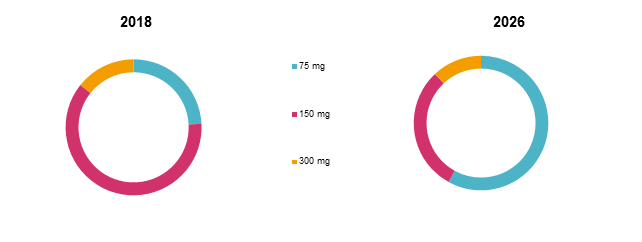Healthcare professionals have been keenly interested in the treatment of gastroesophageal reflux disease (GERD) and stomach & intestinal ulcer owing to its increasing prevalence. GERD is common health problem, which leads to serious medical complications and further huge medical expense in its diagnosis and treatment. The two most frequently observed symptoms associated with GERD are heartburn and acid regurgitation. Usually, over-the-counter antacids, proton pump inhibitor, and H-2 receptor blockers are used to decrease the effects of stomach acids or to block acid production.
Ranitidine is a histamine H2 antagonists and available as both over-the-counter (OTC) and prescription drug, indicated in the treatment of gastroesophageal reflux disease (GERD). Ranitidine decreases the acid production from stomach for up to 12 hours. Also, ranitidine is commonly used in erosive esophagitis, peptide ulcer disease, and Zollinger–Ellison syndrome. It could be taken orally or intravenously.
The global ranitidine market size was valued at US$ 412.4 Mn in 2017, and is expected to witness a CAGR of 1.8% over the forecast period (2018 – 2026).
Global Ranitidine Market Share (%), By Application: 2018 & 2026

To learn more about this report, Download Free Sample
Source: Coherent Market Insights Analysis (2018)
Growing Research and Development (R&D) on Ranitidine is expected to Boost Market Growth
Various government and private research organizations are increasingly engaged in research and development studies to increase the efficacy of ranitidine and examine possible potential of ranitidine to increase future scope of ranitidine market.
Furthermore, various clinical trials are currently undergoing to identify and compare efficacy between ranitidine and other proton pump inhibitors such as esomeprazole and rabeprazole to measure gastric acid reduction in stomach. With the result of these studies, the efficacy of ranitidine is expected to improve and offer better treatment regimes in reducing excessive gastric acid production in the near future.
For instance, in November 2015, a study to compare the efficacy of rabeprazole extended release (ER) 50 mg versus ranitidine 150 mg in treating erosive gastroesophageal reflux disease (eGERD) is currently in Phase III clinical stage.
Global Ranitidine Market Share (%), By Form: 2018 & 2026

To learn more about this report, Download Free Sample
Source: Coherent Market Insights Analysis (2018)
Rising Cases of Various Gastric Ulcers and Digestive Diseases is expected to Increase Growth of the market
High prevalence of gastroesophageal reflux disease (GERD), intestinal & stomach ulcers, esophagitis, heartburn, and other digestive diseases due to unhealthy lifestyle, changing dietary patterns will lead to increase in demand for ranitidine-based medications in the near future. According to Florida Hospital, 2018 U.S. data statistics, in the U.S. over 60 million adults suffer from acid reflux symptoms every month. Furthermore, the source states that each day an estimated 25 million of the 60 million adults suffers from acid reflux symptoms. Also, according to the same source, about 20% of people with acid reflux will develop gastroesophageal reflux disease (GERD) in the near future.
Heartburn with or without regurgitation is identified as one of the prime symptoms of gastroesophageal reflux disease (GERD). According to World Gastroenterology Organization (WGO), 2015, prevalence of GERD is rapidly increasing worldwide, with differences reported in prevalence ranging from 2.5% to 6.6% in Eastern Asia while slightly higher up to 13.8% to 25.8% in North America.
The reason for high prevalence of GERD is not entirely clear, however, it appears to be correlated with increasing prevalence of obesity, and several dietary factors. In obese patients, excess belly fat exert more pressure on the stomach, which causes backflow of acid causing heartburn. Increasing number of obese patients across the globe will indirectly increase GERD cases and this is expected to fuel growth of ranitidine market. According to World Health Organization (WHO), in 2016, over 1.9 billion adults aged 18 years and above were overweight, of which over 650 million were obese, worldwide. Furthermore, GERD is associated with possible risk of Barrett’s esophagus: a premalignant condition that damages the esophagus tube.
However, stringent regulatory guidelines of FDA in the manufacturing of finished drugs will limit growth of ranitidine market. For instance, in March 2018, the Ministry of Food and Drug Safety, South Korea banned the imports of 150 mg Zantac (ranitidine) supplied by GlaxoSmithKline (GSK) Korea, for 4 months (March to June 2018) due to its different shape and coatings. According to the same source, South Korea’s Ministry of Food and Drug Safety report, GSK violated Pharmaceutical Affairs Act by changing the approved shape of Zantac. Zantac is supposed to be white and round with thin film-coatings on both side, while GSK distributed Zantac with thick coated film and also coating around some of the tablets were slightly broken. Changes in color, taste, and packaging might hurt the safety and efficacy of drugs, which directly affects the quality of product.
Furthermore, one of the major challenges in determining prevalence of GERD is to identify the patients’ suffering with the condition. Patients suffering with GERD-related symptoms do not consult healthcare professionals until the symptom gets severe. . Direct costs associated with GERD disease include costs of over-the-counter and prescription medications, physician office and hospital visits, surgical costs, and costs of treating other possible complications such as Barrett's esophagus and esophageal adenocarcinoma, which may result from the disease. This is expected to limit the growth of ranitidine market, over the forecasted period.
Key players operating in the global ranitidine market include GlaxoSmithKline plc, Boehringer Ingelheim GmbH, Strides Pharma Science Limited (StridesShasun), Tocris Bioscience (R & D Systems), Merck KGaA, and Sun Pharmaceutical Industries Limited among others.
Share
Share
Missing comfort of reading report in your local language? Find your preferred language :
Transform your Strategy with Exclusive Trending Reports :
Frequently Asked Questions
Select a License Type
Joining thousands of companies around the world committed to making the Excellent Business Solutions.
View All Our Clients